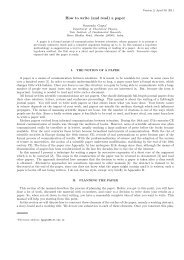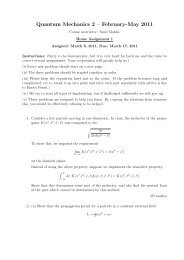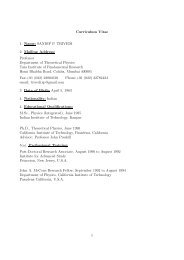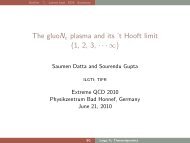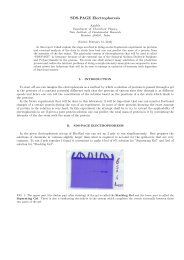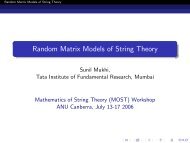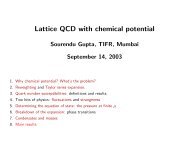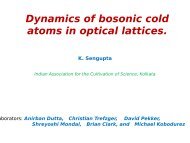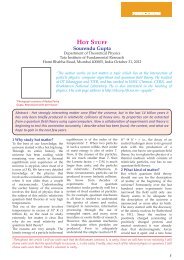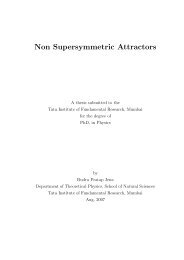Sterile neutrinos - Department of Theoretical Physics - Tata Institute ...
Sterile neutrinos - Department of Theoretical Physics - Tata Institute ...
Sterile neutrinos - Department of Theoretical Physics - Tata Institute ...
You also want an ePaper? Increase the reach of your titles
YUMPU automatically turns print PDFs into web optimized ePapers that Google loves.
Neutrino <strong>Physics</strong>: Lecture 12<br />
<strong>Sterile</strong> <strong>neutrinos</strong><br />
Amol Dighe<br />
<strong>Department</strong> <strong>of</strong> <strong>Theoretical</strong> <strong>Physics</strong><br />
<strong>Tata</strong> <strong>Institute</strong> <strong>of</strong> Fundamental Research<br />
Apr 5, 2010
Outline<br />
1 Short baseline experiments and LSND anomaly<br />
2 Adding a fourth neutrino<br />
3 Constraining the sterile neutrino<br />
4 <strong>Sterile</strong> neutrino in astrophysics and cosmology
Outline<br />
1 Short baseline experiments and LSND anomaly<br />
2 Adding a fourth neutrino<br />
3 Constraining the sterile neutrino<br />
4 <strong>Sterile</strong> neutrino in astrophysics and cosmology
SBLs: When only one ∆m 2 matters<br />
No CP violation, any number <strong>of</strong> <strong>neutrinos</strong>:<br />
P αβ = δ αβ − ∑ i
SBLs: When only one ∆m 2 matters<br />
No CP violation, any number <strong>of</strong> <strong>neutrinos</strong>:<br />
P αβ = δ αβ − ∑ i
Equi-probabilty contours<br />
sin 2 2θ eff sin 2 (∆) = Constant
Short baseline and sensitivity to ∆m 2<br />
Nontrivial P αα or P αβ only when ∆ 1<br />
Atmospheric <strong>neutrinos</strong>:<br />
E ∼ 1 GeV, L ∼ 10 3 km ⇒ ∆m 2 10 −3 eV 2<br />
Reactor <strong>neutrinos</strong>:<br />
E ∼ 1 MeV, L ∼ 1 km ⇒ ∆m 2 10 −3 eV 2<br />
Long baseline experiments:<br />
E ∼ 1–10 GeV, L ∼ 10 3 –10 4 km ⇒ ∆m 2 10 −3 eV 2<br />
Accelerator (short baseline) experiments:<br />
E ∼ 10–100 MeV, L ∼ 1 km ⇒ ∆m 2 10 −2 –10 −1 eV 2
Neutrino experiments with 2ν approximation
Solar and atmospheric experiments
Results from short baseline experiments
The LSND excess<br />
¯ν µ → ¯ν e oscillations !<br />
Excess = 87.9 ± 22.4 ± 6.0 events
L/E oscillations in LSND<br />
Oscillation probability 0.264 ± 0.067 ± 0.045<br />
∆m 2 ≈ 0.2–10 eV 2
The LSND parameter space<br />
hep-ex/0104049
A fourth neutrino ?<br />
Three independent ∆m 2 :<br />
∆m⊙ 2 ≈ 8 × 10 −5 eV 2<br />
∆matm 2 ≈ 2.5 × 10−3 eV 2<br />
∆m⊙ 2 ≈ 0.2–10 eV 2<br />
Not possible with only three neutrino masses !<br />
A fourth neutrino species must be present
A fourth neutrino ?<br />
Three independent ∆m 2 :<br />
∆m⊙ 2 ≈ 8 × 10 −5 eV 2<br />
∆matm 2 ≈ 2.5 × 10−3 eV 2<br />
∆m⊙ 2 ≈ 0.2–10 eV 2<br />
Not possible with only three neutrino masses !<br />
A fourth neutrino species must be present
Outline<br />
1 Short baseline experiments and LSND anomaly<br />
2 Adding a fourth neutrino<br />
3 Constraining the sterile neutrino<br />
4 <strong>Sterile</strong> neutrino in astrophysics and cosmology
A fourth generation neutrino ?<br />
LEP: e + e − → Z → f ¯f<br />
Effective number <strong>of</strong> <strong>neutrinos</strong>: N ν = 2.985 ± 0.008<br />
Only three light <strong>neutrinos</strong> interact with Z<br />
The fourth neutrino has to be sterile !
What is a (light) sterile neutrino<br />
A fermion without electric charge<br />
Does not have electroweak interactions<br />
(Does not interact with W , Z , γ)<br />
Can have interactions beyond the Standard Model (BSM)<br />
Can mix with “active” <strong>neutrinos</strong> due to the BSM<br />
interactions<br />
NOT the right-handed partner <strong>of</strong> active <strong>neutrinos</strong>
What is a (light) sterile neutrino<br />
A fermion without electric charge<br />
Does not have electroweak interactions<br />
(Does not interact with W , Z , γ)<br />
Can have interactions beyond the Standard Model (BSM)<br />
Can mix with “active” <strong>neutrinos</strong> due to the BSM<br />
interactions<br />
NOT the right-handed partner <strong>of</strong> active <strong>neutrinos</strong>
What is a (light) sterile neutrino<br />
A fermion without electric charge<br />
Does not have electroweak interactions<br />
(Does not interact with W , Z , γ)<br />
Can have interactions beyond the Standard Model (BSM)<br />
Can mix with “active” <strong>neutrinos</strong> due to the BSM<br />
interactions<br />
NOT the right-handed partner <strong>of</strong> active <strong>neutrinos</strong>
What would the neutrino mass spectrum look like ?<br />
Mixing matrix: 6 angles and 10 phases<br />
U = Φ(χ 1 , χ 2 , χ 3 , χ 4 ) U 14 (θ 14 , δ 14 ) U 34 (θ 34 , 0) U 24 (θ 24 , δ 24 )<br />
×U 23 (θ 23 , 0) U 13 (θ 13 , δ 13 ) U 12 (θ 12 , 0) Φ(φ 1 , φ 2 , φ 3 , 0)
Outline<br />
1 Short baseline experiments and LSND anomaly<br />
2 Adding a fourth neutrino<br />
3 Constraining the sterile neutrino<br />
4 <strong>Sterile</strong> neutrino in astrophysics and cosmology
Testing the LSND anomaly<br />
MiniBOONE:<br />
E ∼ 1 GeV, L ∼ 1 km<br />
ν µ as well as ¯ν µ beams
Constraining sterile ν from appearance experiments
Constraints from disappearance experiments<br />
Solar <strong>neutrinos</strong><br />
SNO indicates that most ν e go to ν µ or ν τ<br />
⇒ bound on ν e –ν s mixing<br />
Atmospheric <strong>neutrinos</strong><br />
Extra contribution to atmospheric oscillations:<br />
P µµ ≈ P µµ (3ν) − 1 2 sin2 2θ µs<br />
⇒ bound on ν µ –ν s mixing<br />
Reactor experiments<br />
∆mLSND 2 would contribute to KamLAND, K2K, MINOS<br />
⇒ bound on ν e –ν s and ν µ –ν s mixing<br />
∆mLSND 2 would contribute to CHOOZ<br />
⇒ bound on ν e –ν s and ν µ –ν s mixing
Constraints from disappearance experiments<br />
Solar <strong>neutrinos</strong><br />
SNO indicates that most ν e go to ν µ or ν τ<br />
⇒ bound on ν e –ν s mixing<br />
Atmospheric <strong>neutrinos</strong><br />
Extra contribution to atmospheric oscillations:<br />
P µµ ≈ P µµ (3ν) − 1 2 sin2 2θ µs<br />
⇒ bound on ν µ –ν s mixing<br />
Reactor experiments<br />
∆mLSND 2 would contribute to KamLAND, K2K, MINOS<br />
⇒ bound on ν e –ν s and ν µ –ν s mixing<br />
∆mLSND 2 would contribute to CHOOZ<br />
⇒ bound on ν e –ν s and ν µ –ν s mixing
Constraints from disappearance experiments<br />
Solar <strong>neutrinos</strong><br />
SNO indicates that most ν e go to ν µ or ν τ<br />
⇒ bound on ν e –ν s mixing<br />
Atmospheric <strong>neutrinos</strong><br />
Extra contribution to atmospheric oscillations:<br />
P µµ ≈ P µµ (3ν) − 1 2 sin2 2θ µs<br />
⇒ bound on ν µ –ν s mixing<br />
Reactor experiments<br />
∆mLSND 2 would contribute to KamLAND, K2K, MINOS<br />
⇒ bound on ν e –ν s and ν µ –ν s mixing<br />
∆mLSND 2 would contribute to CHOOZ<br />
⇒ bound on ν e –ν s and ν µ –ν s mixing
LSND parameter space ruled out<br />
ArXiv:0906.1997
Can more than one sterile <strong>neutrinos</strong> help ?<br />
Need 2 <strong>neutrinos</strong> <strong>of</strong> masses eV<br />
Constraints from cosmology
Outline<br />
1 Short baseline experiments and LSND anomaly<br />
2 Adding a fourth neutrino<br />
3 Constraining the sterile neutrino<br />
4 <strong>Sterile</strong> neutrino in astrophysics and cosmology
<strong>Sterile</strong> <strong>neutrinos</strong> in astrophysics<br />
Nucleosynthesis <strong>of</strong> heavy elements (r-process)<br />
Heavy elements need more neutrons<br />
ν e tend to reduce number <strong>of</strong> neutrons: ν e + n → e − + p<br />
ν e → ν s conversion can allow heavy elements to be formed,<br />
if ∆m 2 ∼ 10–100 eV 2<br />
Supernova explosions<br />
Conversions to ν s carry away energy efficiently<br />
⇒ May affect explosion dynamics<br />
Can create large asymmetries in ν emission<br />
⇒ May explain large pulsar velocities
<strong>Sterile</strong> <strong>neutrinos</strong> in astrophysics<br />
Nucleosynthesis <strong>of</strong> heavy elements (r-process)<br />
Heavy elements need more neutrons<br />
ν e tend to reduce number <strong>of</strong> neutrons: ν e + n → e − + p<br />
ν e → ν s conversion can allow heavy elements to be formed,<br />
if ∆m 2 ∼ 10–100 eV 2<br />
Supernova explosions<br />
Conversions to ν s carry away energy efficiently<br />
⇒ May affect explosion dynamics<br />
Can create large asymmetries in ν emission<br />
⇒ May explain large pulsar velocities
<strong>Sterile</strong> <strong>neutrinos</strong> in cosmology<br />
keV <strong>neutrinos</strong> are viable dark matter candidates<br />
Can help in producing supermassive black holes<br />
Predicted by some models (e.g. νMSM) that explain<br />
baryon asymmetry
(Not) the last word on sterile <strong>neutrinos</strong><br />
eV-<strong>neutrinos</strong> not required for explaining oscillation data,<br />
Not ruled out either (only mixing constrained)<br />
Can help some astrophysical phenomena<br />
if ∆m 2 ∼ 10–100 eV 2 , very small mixing<br />
keV-<strong>neutrinos</strong> may play a role in cosmology,<br />
structure formation
(Not) the last word on sterile <strong>neutrinos</strong><br />
eV-<strong>neutrinos</strong> not required for explaining oscillation data,<br />
Not ruled out either (only mixing constrained)<br />
Can help some astrophysical phenomena<br />
if ∆m 2 ∼ 10–100 eV 2 , very small mixing<br />
keV-<strong>neutrinos</strong> may play a role in cosmology,<br />
structure formation
(Not) the last word on sterile <strong>neutrinos</strong><br />
eV-<strong>neutrinos</strong> not required for explaining oscillation data,<br />
Not ruled out either (only mixing constrained)<br />
Can help some astrophysical phenomena<br />
if ∆m 2 ∼ 10–100 eV 2 , very small mixing<br />
keV-<strong>neutrinos</strong> may play a role in cosmology,<br />
structure formation






